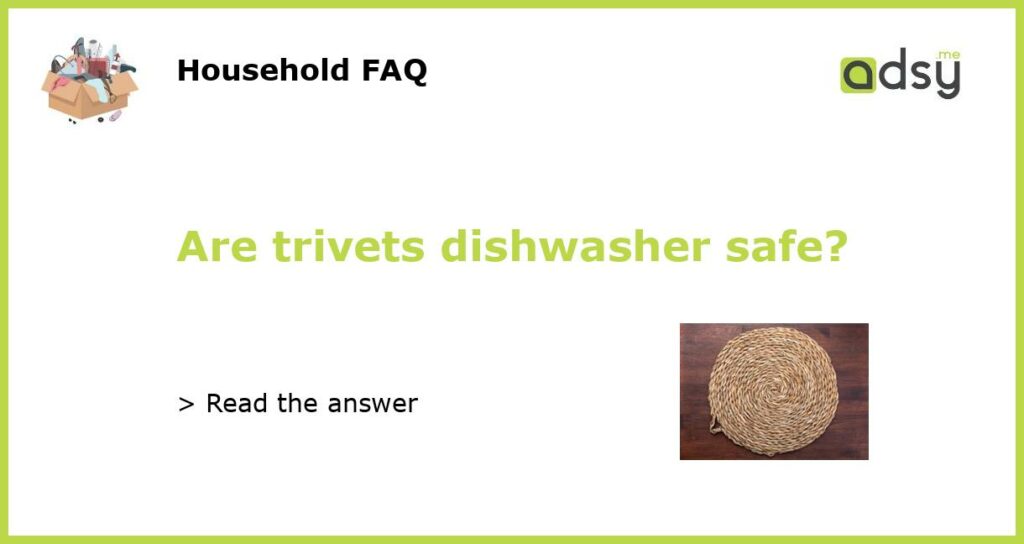What are trivets?
Trivets are small heat-resistant pads or mats that are used to protect countertops, tables, and other surfaces from hot pans, pots, and dishes. They serve as a buffer between the hot cookware and the surface, preventing damage and burns. Trivets can be made from various materials such as silicone, metal, ceramic, or cork.
Why use trivets?
Using trivets has several benefits. Firstly, they protect your countertops and tables from heat damage. Placing a hot pan directly on the surface can cause it to discolor, warp, or even crack. By using a trivet, you create a barrier that prevents direct contact between the hot cookware and the surface, preserving its appearance and integrity.
In addition to protecting the surface, trivets also help to maintain the temperature of the hot dish or pan. When you place a hot pan directly on a cool surface, it can cause the temperature of the food to drop rapidly. By using a trivet, you allow for better heat retention and ensure that your food stays warm for longer.
Another benefit of using trivets is that they provide stability to your cookware. Some trivets have non-slip surfaces or feet that prevent pans and dishes from sliding or tipping over. This can be especially useful when serving food at the table or when working with heavy or awkwardly shaped cookware.
Are trivets dishwasher safe?
The dishwasher-safe status of trivets depends on the material they are made from. While some trivets, like silicone and certain types of metal, are typically safe to place in the dishwasher, others may not be.
If you have a silicone trivet, you can usually safely place it in the dishwasher for convenient cleaning. Silicone is a heat-resistant material that is also non-stick, making it easy to clean. Just be sure to check the manufacturer’s instructions to confirm that your specific trivet is dishwasher safe.
On the other hand, trivets made of metal, such as stainless steel or cast iron, may not always be suitable for the dishwasher. While metal trivets are generally durable and easy to clean, they can still be subject to rust or damage if exposed to harsh dishwasher detergents and high temperatures. It is best to consult the care instructions provided by the manufacturer before placing your metal trivet in the dishwasher.
Ceramic trivets may also require special care when it comes to cleaning. Some ceramic trivets may have delicate finishes or painted designs that can be damaged by the dishwasher. It is recommended to hand wash ceramic trivets to prevent any potential damage. Similarly, trivets made of cork may not hold up well in the dishwasher due to their absorbent nature. Hand washing is typically the safest method for cleaning cork trivets.
How to clean trivets?
If your trivet is dishwasher safe, you can simply place it in the dishwasher along with your other dishes and utensils. Be mindful of any specific instructions provided by the manufacturer regarding water temperature or dishwasher detergent.
If your trivet is not dishwasher safe or if you prefer to hand wash it, you can clean it with warm soapy water and a sponge or cloth. Gently scrub the trivet to remove any food particles or stains. Rinse it thoroughly and allow it to air dry before storing it.
For particularly stubborn stains or residue, you can create a paste using baking soda and water. Apply the paste to the stained areas, let it sit for a few minutes, and then scrub the trivet with a sponge or brush. Rinse well and air dry.
Tips for trivet care
To prolong the lifespan of your trivets and keep them looking their best, here are a few tips:
1. Read the manufacturer’s care instructions – Different materials may have specific cleaning and care requirements. Always follow the guidelines provided by the manufacturer.
2. Avoid placing hot trivets on delicate surfaces – While trivets protect your countertops, be cautious when placing hot trivets on delicate materials such as wood or laminate. Some trivets have raised feet or textures that can leave marks or scratches.
3. Store trivets properly – When not in use, store your trivets in a cool, dry place away from direct sunlight or heat sources. This will help prevent any potential damage or warping.
4. Check for damage – Regularly inspect your trivets for any signs of damage such as cracks or loose parts. If a trivet becomes damaged, it may not provide adequate protection and should be replaced.
By following these tips, you can ensure that your trivets remain in good condition and continue to provide effective heat protection for your surfaces.






